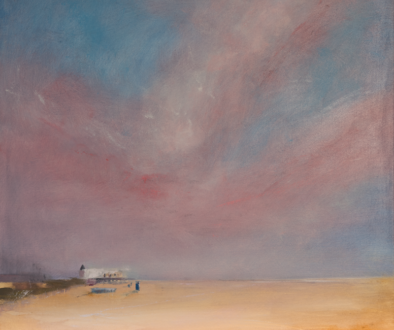Edelman Planetarium at Rowan University
Talk about a reality check.
The astronomy shows at Rowan University’s Edelman Planetarium feature a cosmic chart, projected on a 40-foot overhead dome inside a darkened theater. It shows Earth as an infinitesimal blip in the Milky Way, which itself is just a dot on a vast universal map.
Clearly, we humans aren’t the center of the universe.
It’s a staggering realization. It’s a little humbling. And the night I visited, it held the audience spellbound. During the hour-long program, I heard no murmuring, seat-shifting, or other signs of restlessness, even among the littlest spectators. Everyone just sat there in tipped-back seats, gazing open-mouthed at the cosmos.

Think of the show as a high-definition movie, screened under a big, inverted teacup. My evening started with the stargazing portion, informative but informal, hosted by a cheery doctoral candidate named Emily. She showed us how to identify the constellations, told some out-of-this-world puns, and gamely fielded questions from the crowd. That was followed by a 30-minute documentary, “Experience the Aurora,” about the Northern Lights, filmed with special cameras with fisheye lenses over seven months in the Arctic Circle. It was stirring and spectacular.
The program also demonstrated what the night sky over New Jersey would look like without the artificial light that floods our coast. And believe me, we’re missing a fine spectacle, crowded with stars, planets, meteors, and moons.
“The east coast is one of most light-polluted areas in the country,” explains planetarium director Amy Barraclough. “Light pollution affects all sorts of things, including circadian rhythms, and has been shown to increase health effects for people. It affects wildlife as well.”
For example, newly hatched sea turtles use moonlight to make their way to the ocean. In a light-polluted environment, “they emerge from their nests and head towards the brightest light, which can be the city, not the ocean,” says Barraclough. “Clearly, we need dark skies, not just for our own health, but for the health of our ecosystems.”
The facility at Rowan’s Science Center was established in 2004 by philanthropist-alums Ric and Jean Edelman, who also funded the university’s Fossil Park Museum. The dome and an adjoining research observatory regularly host open houses and stargazing shows for individuals and groups, and you sure can’t beat the price of admission: $5 to $8 per person (and free for school groups, thanks to a generous grant by the Edelmans).


Families with young children may want to start with shorter, half-hour shows, held every Saturday at 2pm, for just $4 per person. Recent titles have included “The Magic Tree House: Space Mission” and “Max Goes to the Moon.”
Observatory open houses let visitors view the craters of the moon through high-powered telescopes and get up close and personal with the planets in our solar system—Saturn is always a big crowd-pleaser, because of its familiar rings.
Rounding out the calendar of events are laser music shows, set to the beat of the Beatles, Elton John, Metallica, Pink Floyd, and other artists, including, unavoidably, Taylor Swift (parents, be warned, the Taylor shows sell out well in advance).
“We always do a lot of fun holiday-themed laser shows with holiday music,” adds Barraclough. “One show, called ‘Season of Light,’ is about the traditions of the winter solstice, like decking the halls and giving presents. We have a wide mix, including options for people who just want a fun outing with the family and aren’t necessarily interested in the educational aspect. There’s always something to do at the planetarium.”
Next year’s big event will be the Great North American Eclipse, coming on April 8. It will begin as a total solar eclipse in Mexico, then work its way across the continent, finally darkening local skies at about 2pm Eastern Time.


New Jerseyans will get a partial eclipse, but it will be “a big partial,” says Barraclough, with about 90 percent coverage of the sun by the moon. To prepare, you may want to catch another planetarium show, “Totality,” a new production by Rice University and ePlanetarium.
The 104-seat Edelman Planetarium may be modest compared to its local cousins, the Fels Planetarium at the Franklin Institute, which has an 80-foot dome, and the Jennifer Chalsty Planetarium at the Liberty Science Center in Jersey City, the largest planetarium in America with an 89-foot dome.
While it’s more intimate, its system is equally state-of-the-art and could whet your appetite for more celestial pursuits. I left the show feeling like a tiny cog in a very big cosmos yet connected to it all. It was overwhelming, but also very satisfying.
“Part of our mission is to invoke that awe in people when they visit,” says Conner Marti, the planetarium’s assistant director. “We believe people ought to look up a little more often.” ν



